Recent Articles
Popular Makes
Body Types
Driving Fatigue
Hey! Wake up and drive!

It's only 500 miles to the next hotel. You can do it. Stop off at the next mini-mart, get a 20 oz. coffee and roll down the window. Yeah --- 500 miles is no problem with Quick Serv's extra syrupy coffee running through your system.
Before you know it, the road starts playing tricks on your mind. Or is it the other way around? Lights seem to move sideways --- wait, was that a flashing red light? And why is that person on the road? You slow down. No one's there, though you would have sworn you saw a man running across the freeway lanes. You slam on the brakes to take a corner, thinking you're too late to make the curve. But the road is dark, straight, and --- for you --- headed right into the nearest ditch.
You have a choice that's no choice at all: stop on the side of the road, in the middle of nowhere, or keep on driving, tempting fate to run you off the road.
Wake up. According to the National Sleep Foundation, two-thirds of Americans have sleep-related problems at some time in their life and 23 percent have actually fallen asleep while driving. The National Highway and Transportation Safety Administration (NHTSA) research shows that drowsiness and/or fatigue is a contributing factor in approximately 100,000 motor vehicle crashes annually and is a factor in nearly four percent of all fatal crashes.
Be kind to yourself and your loved ones -- keep these tips from NHTSA in mind:
Set reasonable daily itineraries
Rotate driving shifts if more than one driver is available
Take regular breaks while driving (every two hours)
Restrict night driving
Plan for a good night’s sleep
Get some kind of physical exercise during the day
Maintain a healthy diet, without excessive fats or carbs. Also, avoid sugary foods; the initial rush is fine, but the "letdown" can make you feel worse than before
By Brian Chee Photo credit: Toyota